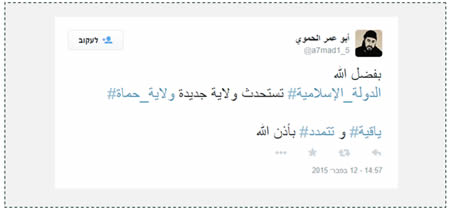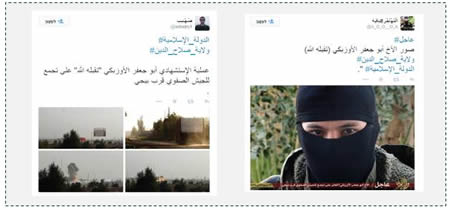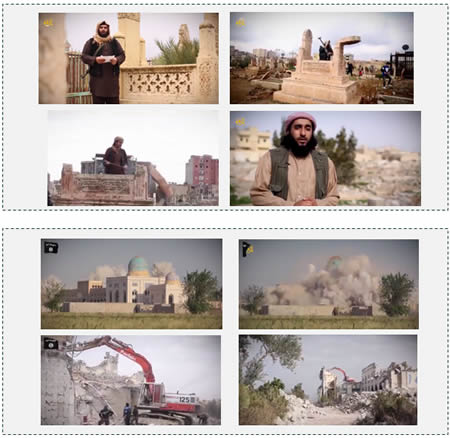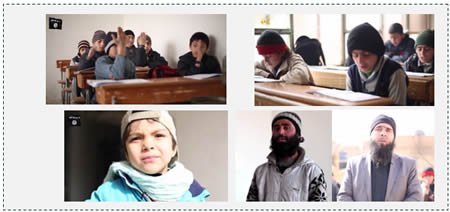Main events of the week[1]
|
Two shooting attacks in Copenhagen[2]
- On the afternoon of February 14, 2015, and at about one a.m. on February 15, 2015, there were two shooting attacks in Copenhagen, Denmark, both carried out by the same terrorist operative. The first occurred during a cultural event in a café in the northern part of the city, and the second during a Jewish bat mitzvah celebration in a synagogue. Two people were killed and five wounded. On February 16, 2015, tens of thousands of people attended a memorial gathering for the victims held in the center of Copenhagen.
- The initial information about the attacks is the following:
- The shooting attack at the Krudttoenden Café in the northern part of Copenhagen: At 15:30 hours on February 14, 2015, a terrorist entered the café and opened fire. At the time an event entitled "Art, Blasphemy and the Freedom of Expression" was in progress. The terrorist fired scores of bullets. One of those present was Lars Vilks, a Swedish cartoonist who published allegedly insulting cartoons depicting the prophet Muhammad in 2007 (for which he received death threats). Also present was François Zimeray, the French ambassador to Denmark, who, after the terrorist attack on the editorial offices of Charlie Hebdo, spoke in favor of the right to freedom of expression in Denmark. Vilks and Zimeray might have been the targets of the attack. Finn Norgaard, 55, a local movie producer was killed and three policemen were wounded.
- The shooting attack at the Jewish bat mitzvah celebration in the Krystalgade synagogue: At 01:00 hours on February 15, 2015, an armed man entered the synagogue on Krystalgade street in central Copenhagen and opened fire. Dan Uzan, 37, a member of the Copenhagen Jewish community, was securing the entrance and was shot in the head and killed. Two policemen also securing the event were wounded. The armed terrorist fled the scene.
- The Danish police said in an announcement that based on video surveillance films, one man carried out both attacks. He was cornered and killed in a shootout with the Danish police at the Copenhagen train station (near his house) about four hours after the attack on the synagogue. According to the Danish media, he was Omar Abd al-Hamid al-Hussein, 22, born in Copenhagen, the son of parents of Palestinian origin. He was known to the Danish law enforcement authorities for committing violent felonies and gun possession (he was released from prison two weeks before the attacks). Weapons were found when his house was searched. After the attacks two individuals were taken into custody on suspicion of aiding and abetting. The Danish security services have not yet revealed what motivated him, however, they are of the opinion he operated alone and had been influenced by the attack on the offices of Charlie Hebdo in Paris.
- According to the Israeli daily newspaper Haaretz correspondent in Copenhagen, Omar Abd al-Hamid al-Hussein's name was on a short list of prisoners who had undergone radical Islamization while in prison, but nevertheless his activities were not being monitored. According to the Danish daily newspaper Ekstra Bladet, Omar al-Hussein posted a video supporting jihad to his Facebook page a short time before the attacks (Haaretz.co.il, February 17, 2015).
|
The terrorist modus operandi in Copenhagen was similar to the attacks carried out in Paris in January 2015. In both instances they were carried out by local jihadist or jihadists who had been influenced and inspired by global jihad organizations to carry out attacks on individuals regarded as having insulted the prophet Muhammad, combined with attacks on Jewish community institutions. Omar Abd al-Hamid al-Hussein may have been copying the attacks in Paris. In ITIC assessment one of the factors responsible for the attack was the intensive propaganda and incitement of ISIS and other jihadi organizations calling on Muslims in Western countries to carry out attacks where they live if they cannot join the fighting in Syria and Iraq. Such incitement may have also motivated jihadist Muslims living in Denmark.[3] |
The international campaign against ISIS
US and coalition airstrikes
nThis past week the coalition forces carried out dozens of airstrikes in Syria and Iraq:
· In Syria airstrikes were carried out in the Al-Raqqah province, the rural areas around Kobanî, Deir al-Zor and Al-Hasakah. The strikes hit tanks and APCs, military posts, a bunker, buildings, control points and oil pumping facilities.
· In Iraq airstrikes were carried out in the areas of Mosul, Kirkuk, Tel Afar, Al- Asad, Sinjar and Al-Fallujah. The strikes hit ISIS units, bulldozers, armed vehicles, weapons, posts and buildings.
Remarks by American envoy to the anti-ISIS coalition
- John Allen, the American envoy to the international anti-ISIS coalition, was interviewed by the Jordanian News Agency in Petra. He said the following:
- The objective of the American-led coalition has not changed and is still to defeat ISIS. An extensive ground offensive will be carried out "very shortly," led by Iraqi forces. The coalition forces have teams of advisors on the ground.
- From the beginning Jordan has played a leading role in the anti-ISIS coalition. He praised Jordan's humanitarian and political role, adding that Jordan prevented foreign fighters from reaching Syria and Iraq.
- The coalition supports and trains the [Sunni] tribes. The tribesmen are an effective anti-ISIS force in the Al-Anbar province in Iraq as they were an effective anti-Al-Qaeda force in the same region in the past.
- The situation in Syria is more difficult than the one in Iraq. That is because the United States has partners in Iraq, in the form of the Iraqi government and its head, Abadi, whereas the Assad regime in Syria is not a United States partner.
- Asked if American weapons and training assistance to the Iraqi army was being delayed, John Allen answered that the United States was doing its best to provide the Iraqi army with weapons and training as quickly as possible.
Main developments in Syria
Hama
- On February 12, 2015, an ISIS-affiliated Twitter account claimed that Hama had been declared a new Islamic State province. At this stage it is unclear what ISIS's strength in Hama actually is.

Hama is declared a new Islamic State province (an ISIS-affiliated Twitter account, February 12, 2015).
Aleppo province
- Battles continue in the Aleppo province between ISIS and its rivals in various locations. There is still fighting in the rural area around Kobanî between the Kurdish YPG forces and ISIS forces that retreated from the city. Reportedly, 75 ISIS operatives were killed in the clashes and the Kurdish forces had taken over several additional areas (Syriahr.com, February 15, 2015). ISIS operatives were also involved in clashes with the Syrian army in the region of the city of Suran (about 60 kilometers, or 37 miles, northwest of Aleppo).
Main developments in Iraq
Salah al-Din province
- Battles continue in the Salah al-Din province between ISIS and the Shi'ite militias in the region of Samara, north of Baghdad. An ISIS-affiliated Twitter account posted a claim that ISIS operatives had conquered the region of Al-Ukhaydir, near Samara. The photo posted with the claim shows ISIS operatives crossing the Tigris river in boats after the region had been cleared (ISIS-affiliated Twitter account, file sharing website, February 13, 2015). It was also reported that ISIS operatives had taken control of the town of Al-Dujail, about 20 kilometers, or 12 miles, north of Samara (Islamtoday.net, February 12, 2015).
- In the region of the oil city of Baiji battles continue between ISIS and the Iraqi Shi'ite militias. On February 14, 2015, ISIS posted pictures of a booby-trapped truck attack carried out by a suicide bomber nicknamed Abu Jaafar the Uzbek, apparently on February 5, 2015. It targeted Iraqi army forces near Baiji.

The booby-trapped truck that exploded near Baiji, Iraq, and the suicide bomber who carried out the attack (ISIS-affiliated Twitter account, February 13 and 14, 2015).
Al-Anbar province
- ISIS continues its efforts to clear the province of pockets of resistance. ISIS operatives took control of large areas of the town of Albaghdadi, northwest of Ramadi. According to the Washington Post, about 1,000 ISIS operatives participated in the attack on Albaghdadi (Longwarjournal.feb 13, date, 2015)
Kirkuk province
- On February 13, 2015, an ISIS-affiliated Twitter account posted pictures of Kurdish Peshmerga fighters captured by ISIS. They were caged and dressed in orange, a possible warning that ISIS was preparing to burn them alive, as it had the Jordanian pilot.

Caged Kurdish Peshmerga fighters captured by ISIS (ISIS-affiliated Twitter account, February 13, 2015)
The conduct of the Islamic State
Cyber warfare waged by ISIS-affiliated hackers
- On February 13, 2015, an ISIS-affiliated Twitter account posted the claim that ISIS-affiliated hackers had hacked into the websites of the Islamic Emirates' Al-Ittihad newspaper and the Abu Dhabi TV channel.
- The Orient TV channel reported that ISIS had hacked into its website and posted threats and insults targeting the owners and employees. The ISIS hackers changed the site's background and wording (Orient TV, February 12, 2015).
American estimates of the number of ISIS operatives
- American intelligence officials estimate that ISIS has between 20,000 and 30,000 operatives in Syria and Iraq (Nytimes.com, February 14, 2015). That is the same as the CIA estimate published a number of months ago.[4] However, apparently the relative number of foreign fighters in the ranks of ISIS in Syria and Iraq is rising.
- In American assessment, the coalition airstrikes in Iraq and Syria have not slowed the rate at which foreign fighters enlist in the ranks of ISIS and other jihadi groups. AP, quoting American intelligence officials, noted that today there were about 20,000 foreign fighters in the ranks of ISIS from 90 different countries, at least 3,400 of them from Western countries. According to American intelligence officials, about 150 American citizens tried, some successfully, to reach combat zones in Syria. Some were detained on their way to Syria, others were killed and a small number were still fighting (AP.org, February 11, 2015). More than 12,000 foreign fighters from the Arab countries are fighting in Syria, most of them from Tunisia, Saudi Arabia, Jordan and Morocco (Sky News Arabic, February 12, 2015).
- Nick Rasmussen, director of the American National Counterterrorism Center at the Office of the Director of National Intelligence, said that the rate of foreign fighter travel to Syria was unprecedented. He said it far exceeded the rate of foreigners who went to wage jihad in Afghanistan, Pakistan, Iraq, Yemen or Somalia at any other point in the past 20 years (Foxnews.com, February 10, 2015).
Graves desecrated in Al-Raqqah province
- On February 14, 2015, ISIS's propaganda department in the Al-Raqqah province posted a video of the extensive, systematic desecration of the graves of Muslim holy men and the destruction of mosques of non-Sunni Muslim denominations. An ISIS operative interviewed for the video claimed that thousands of graves had already been destroyed in the Al-Raqqah province by ISIS's "morality police (al-hisbah)." He claimed they were planning to "take care of" two other cemeteries. He quoted sayings of the prophet Muhammad about idolatry (ISIS-affiliated Twitter account, February 14, 2015).

The desecration of the graves of Muslim holy men and the blowing up of mosques carried out by ISIS (ISIS-affiliated Twitter account, February 14, 2015)
|
The destruction of graves and statues is a familiar tactic of ISIS and other Salafist-jihadi organizations. It is rooted in the history of Islam and based on a saying of the prophet Muhammad. During ISIS's conquests in Iraq and its gaining a foothold in Syria it desecrated graves and blew up ancient statues and otherwise destroyed cultural treasures dating from the dawn of civilization.[5] |
ISIS's educational system
- On February 12, 2015 an ISIS-affiliated forum posted a video about the establishment of the Imam al-Bukhari school in the Tel Abiad region of the Al-Raqqah province. Local children, both boys and girls between the ages of six and 12, study there, as do the children of foreign fighters. A six year-old boy said that he came to Syria with his mother and father from Belgium (Shabakataljahad.net. February 12, 2015).

Pupils and teachers at the Imam al-Bukhari school in the Tel Abiad region of the Al-Raqqah province, Syria (Shabakataljahad.net. February 12, 2015)
Egypt and the Sinai Peninsula
Execution of alleged Israeli and Egyptian army agents
- On February 9, 2015, an ISIS-affiliated Twitter account posted the picture of a man who had been beheaded named Yasser Ibrahim Mahmoud Awad Zayid, from the Al-Rumaylat tribe. ISIS claimed he had allegedly confessed to being "an agent of the Jews" [i.e., Israel]. Pictures were also posted of men accused of being agents for the Egyptian army, and they were beheaded by ISIS operatives in the Sinai Peninsula. There was also a picture of an Egyptian army officer named Muhammad Sa'ad, who ISIS claimed had been captured by its operatives.

Sameh Salim Suweilah, who was beheaded, according to the claim of the ISIS branch in the Sinai Peninsula, because he was an Egyptian army agent. The Arabic reads, "These are the agents of the Jews and El-Sisi's infidel army, and this is the fate of every spy whose lords are the Jews and those who reject Islam" (ISIS-affiliated Twitter account, February 9, 2015)
Global jihad organizations in other countries
Execution of Copts in Libya and Egypt's response
- On February 15, 2015, the "Tripoli province" of the Islamic State in Libya executed 21 Egyptian Coptic immigrant workers who had been abducted in Libya (by the so-called "armies of the Islamic Caliphate in Tripoli"). They were beheaded by masked ISIS operatives on a beach in Libya and their deaths were documented on a video made public by Al-Hayat, an ISIS media outlet. The video was entitled "A Message Signed With Blood To The Nation Of The Cross." The speaker says "The sea you have hidden Sheikh Osama bin Laden’s body in, we swear to Allah we will mix it with your blood." The prisoners were then made to kneel on the ground and beheaded. The speaker then lifts a bloody knife and says, “We will conquer Rome, by Allah’s permission."[6]
- In response, on February 16, 2015, the Egyptian air force attacked targets in Dernah and Sirte, two ISIS strongholds in Libya. The Egyptian media reported that training camps, ISIS deployment sites and weapons stores were hit. According to reports from Libya, dozens of jihadist operatives were killed in the airstrikes.
ISIS gains a foothold in Libya
- According to an article in the New York Times on February 14, 2015, in Libya there are three groups that have pledged loyalty to ISIS. One is in the city of Barqa, in the east of the country; the second is the city of Fezzan, in the south desert; and the third is Tripolitania, in the west, near the capital. "Provinces" of the Islamic State were established in those areas.
- According to the article, "Western officials, especially in southern Europe, fear that the three Libyan 'provinces' could evolve into bases for Islamic State fighters traveling across the Mediterranean, into Egypt or elsewhere in North Africa. Eastern Libya has already become a training ground for jihadists going to Syria or Iraq and a haven for Egyptian fighters staging attacks in the neighboring desert."[7]
- However, the ISIS provinces in Libya show intensive military activity on the ground:
- On February 13, 2015, an ISIS-affiliated Twitter account posted a picture of a shoulder-launched missile which, it was claimed, downed a Libyan army helicopter. The aircraft fell in the area between Sirte and Bin Jawad in the central coastal region (about 157 kilometers, or about 97 miles, east of Sirte).
- On February 14, 2015, Arab news sites claimed that ISIS had taken over government buildings and media in the city of Sirte, and was on its way to making its takeover of the city complete (Albawaba.com, February 14, 2015; Akhbarona.com and Islammemo.cc, February 15, 2015). ISIS also claimed it had taken control of the city of Al-Naufaliyah, and was approaching the oil port of Sidra (Alquds.co.uk, February 10, 2015).
The attack on the kosher supermarket in Paris (update)
- The most recent issue (number 7) of the ISIS English-language magazine Dabiq published an interview with Hayat Boumeddiene (the life partner of Amedy Coulibaly), who fled to Syria. Boumeddiene, aka Um Bashir Muhajira, called on Muslim women to love Allah and his messenger [Muhammad] and to support their fighting husbands. She also praised life in the Islamic State, where Islamic religious law was implemented (Longwarjournal.org, Insidethejihad.com).
Counterterrorism
Salafist-jihadi leader in Belgium sentenced to 12 years in prison
- On February 11, 2015, a Belgian court sentenced Fouad Belkacem, the leader of the Salafist-jihadi organization Sharia4Belgium, to 12 years in prison. The trial began in September 2014 and was held in Antwerp. Forty-five other members of the organization were also tried (most of them in absentia; only eight were present in court). They were given prison sentences of between three and five years. The Belgian judge said during sentencing that there was no doubt that "Sharia4Belgium is a terrorist organization" that had brainwashed young Belgians and sent dozens of them to fight in Syria in the ranks of terrorist organizations such as ISIS.
- Sharia4Belgium was established in 2010 with the objective of enforcing the sharia (Islamic religious law) in Belgium. One of its activities was sending young Belgians to fight in Syria, and to that end provided them with logistic support.[8] Similar networks were later founded in Europe and beyond, and the "Sharia4" organizations became a kind of international network using the Internet to spread jihadi ideology. On October 7, 2012, the Belgian authorities outlawed Sharia4Belgium.
- Sharia4Belgium is headed by Fouad Belkacem, a Belgian from Morocco, who became more religious a number of years ago and changed his name to Abu Imran. He preached that homosexuals of both sexes should be killed and said he prayed for Osama bin Laden. Belkacem has a long criminal record that includes convictions in 2002, 2004 and 2007. He was sentenced to prison in Morocco for dealing drugs. In June 2012 he was convicted in Belgium for incitement to hatred against non-Muslims and sentenced to two years in prison. Paroled in February 2013, he was arrested again because he had violated the terms of his parole and returned to finish his sentence. He has now been sentenced to 12 years in prison, along with other organization activists.
The battle for hearts and minds
ISIS threats of terrorist attacks in the West continue
- On February 14, 2015, ISIS issued a recorded message from Abu Muhammad al-Adnani, the organization's spokesman. He threatened more terrorist attacks in France, Belgium, Canada and Australia (i.e., the countries where jihadists recently carried out terrorist attacks). He mentioned the attacks carried out and warned that the countries should continue to be on alert, and would live in fear and insecurity (YouTube, February 14, 2015).
- On February 14, 2015, the same day, a video was posted to YouTube showing two French-speaking ISIS operatives with the organization's flag. They said, "We are waiting for the order to blow you up and kill you. The nightmare begins now. We will show you no mercy. We are here to enforce the rule of Allah and it is the only rule we accept in the world along with the sharia" (YouTube, February 14, 2015).
[1]The weekly publication Spotlight on Global Jihad monitors developments among ISIS and global jihad organizations in Syria and Iraq and in the Middle East as a whole. It also monitors terrorist activities around the world, directed, supported or inspired by the global jihad organizations in the Middle East.
[2]Updated to February 17, 2015, based on reports in the Danish, global and Israeli media.
[3]An ITIC bulletin issued more than a year ago noted that according to the Danish security services, about 65 Danes were fighting in Syria. It is probable that since then the number has grown. It can also be assumed that Danish veterans of the fighting in Syria and Iraq have begun returning to their native country. For further information see the February 2, 2014 bulletin "Foreign fighters from Western countries in the ranks of the rebel organizations affiliated with Al-Qaeda and the global jihad in Syria."
[4]On September 11, 2014, a CIA spokesman said intelligence estimated the number of ISIS operatives was between 20,000 and 31,500 in Iraq and Syria. For further information see the November 26, 2014 bulletin "ISIS: Portrait of a Jihadi Terrorist Organization."
[5]For further information see the November 26, 2014 bulletin "ISIS: Portrait of a Jihadi Terrorist Organization."
[6]http://www.thedailybeast.com/articles/2015/02/16/egypt-s-jets-retaliate-for-slaughter-of-christians-hit-isis-in-libya.html
[7]http://www.nytimes.com/2015/02/15/world/middleeast/islamic-state-sprouting-limbs-beyond-mideast.html
[8]In the ITIC bulletin issued a year ago, the Danish minister of the interior was quoted as saying that there were between 100 and 150 Belgians jihadists participating in the fighting against the Assad regime. Other estimates ranged between 200 and 300. Since then the number has probably risen. The numbers of Belgians is the highest in Europe relative to the country's population. It can be assumed that the activities of Fouad Belkacem made a great contribution. For further information see the February 3, 2014 bulletin "Foreign fighters from Western countries in the ranks of the rebel organizations affiliated with Al-Qaeda and the global jihad in Syria."














